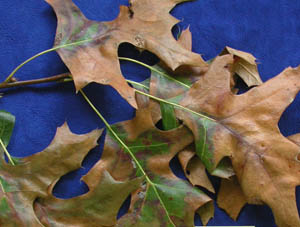 Add into the equation that there are other diseases and boring
insects that cause similar problems, and we end up with some
confusion. Much of the information Illinois is using has come to
us from Michigan State University, where they have been battling
the problem for many years. Symptoms of infestation of emerald
ash borer include canopy dieback, shoots coming from the base of
the tree, splitting bark, serpentine feeding galleries under the
bark, increased woodpecker activity and "D"-shaped exit holes.
Remember, many other problems cause many of these same symptoms. Add into the equation that there are other diseases and boring
insects that cause similar problems, and we end up with some
confusion. Much of the information Illinois is using has come to
us from Michigan State University, where they have been battling
the problem for many years. Symptoms of infestation of emerald
ash borer include canopy dieback, shoots coming from the base of
the tree, splitting bark, serpentine feeding galleries under the
bark, increased woodpecker activity and "D"-shaped exit holes.
Remember, many other problems cause many of these same symptoms.
The emerald ash borer does not do well moving from one place to
another on its own. Most of the help comes from humans moving
firewood, lumber or other items made from infested trees. This
movement of products is why the insect "leapfrogs" from one
place to another, often many miles away.

Many people have asked to have their ash trees looked at to
see if they have it. That is all well and good, but remember, it
can be in your tree for up to five years before it shows any
symptoms that can be seen. The other question is: How do I save
my ash tree? To that end, here are some of the things to look at
when considering an attempt at insecticidal control.
Phil Nixon, University of Illinois Extension entomologist,
lists several things to look at. First, the only certain method
to control emerald ash borer is to remove the tree. This sounds
extreme, but any control attempt is only effective in the 80-90
percent range. Second, the cost of treatment over a span of
years should be looked at. It might cost only $35 to treat for
one year, but that will really add up over 20 years, with
increasing costs each year. And third, a tree in a regulated
area is subject to removal by governmental agencies regardless
of whether it has been treated or shows signs of infestation.
There are treatment options for professionals and homeowners
to use. It is recommended to preventively treat ash trees no
more than 15 miles from known infestations. Control is usually
more effective on smaller trees, and treatment is not as
effective on trees already infested. The major treatment option
for homeowners is to apply Merit (imidacloprid) insecticide as a
soil treatment on an annual basis. This treatment will be more
effective in the spring, and it takes a month or two to
translocate in the tree. Also remember your tree can still be
cut down if it is in the zone of a known infestation, whether it
has been treated or not.
[to top of second column]
 |

If you see emerald ash borer or its damage, you may call the
Extension office at 732-8289 or the Illinois Department of
Agriculture at 800-641-3934. More information is available online at
www.illinoiseab.com and
www.emeraldashborer.info.

Falling leaves
With the severe disease and insect pressure we have had, leaves
are falling. As we approach September, some of this is to be
expected, but some of it is due to damage from insects and diseases.
Severely damaged leaves tend to drop early, especially when the leaf
attachment is weakened. The causes are various, including bacterial
leaf scorch on pin oaks and red oaks, apple scab on apples and crab
apples, anthracnose on many good-quality shade trees, verticillium
wilt on quality maples and ash trees, and of course Japanese beetle
damage on many types of trees.
Bacterial leaf scorch will be an ongoing problem and is
life-threatening to trees, as is the verticillium wilt. These
diseases plug the tissue that carries water to the plant parts, and
there is no control. Fertilization is about the only option
(fertilize at the lawn rate to prevent problems to other plants).
The other disease and insect problems happen on an annual basis, and
trees should leaf out normally next year. You may, or may not, have
the problems again next year, depending on the weather.
[By
JOHN FULTON,
University of Illinois Extension, Logan County]
 |